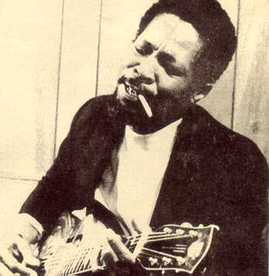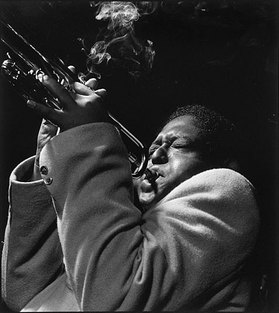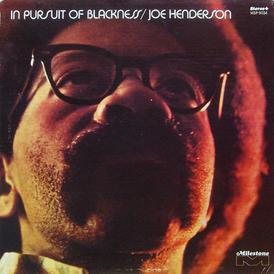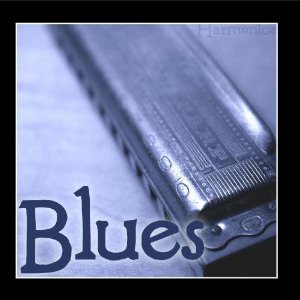BLUES ARTIST BIRTHDAY:
Tarheel Slim (1924) - Talk about a versatile musician: Alden “Tarheel Slim” Bunn recorded in virtually every postwar musical genre imaginable. Lowdown blues, gospel, vocal group R&B, poppish duets, even rockabilly weren't outside the sphere of his musicianship. However, spirituals were Bunn's first love. While still in North Carolina during the early '40s, the guitarist worked with the Gospel Four and then the Selah Jubilee Singers, who recorded for Continental and Decca. Bunn and Thurman Ruth broke away in 1949 to form their own group, the Jubilators. During a single day in New York in 1950, they recorded for four labels under four different names! One of those labels was Apollo, who convinced them to go secular. That's basically how The Larks, one of the seminal early R&B vocal groups whose mellifluous early-'50s Apollo platters rank with the era's best, came to be. Bunn sang lead on a few of their bluesier items ("Eyesight to the Blind," for one), as well as doing two sessions of his own for the firm in 1952 under the name of Allen Bunn. As Alden Bunn, he encored on Bobby Robinson's Red Robin logo the next year. Bunn also sang with another R&B vocal group, The Wheels. And coupled with his future wife, Anna Sanford, Bunn recorded as The Lovers. "Darling It's Wonderful," their 1957 duet for Aladdin's Lamp subsidiary, was a substantial pop seller. Tarheel Slim made his official entrance in 1958 with his wife, now dubbed Little Ann, in a duet format for Robinson's Fire imprint ("It's Too Late," "Much Too Late"). Then old Tarheel came out of the gate like his pants were on fire with a pair of rockabilly raveups of his own, "Wildcat Tamer" and "No. 9 Train," with Jimmy Spruill on blazing lead guitar. After a few years off the scene, Tarheel Slim made a bit of a comeback during the early '70s, with an album for Pete Lowry's Trix logo that harked back to Bunn's Carolina blues heritage. It would prove his last. Alden “Tarheel Slim” Bunn died on August 21, 1977.
JAZZ ARTIST BIRTHDAY:
Fats Navarro (1923) – Jazz trumpeter Theodore "Fats" Navarro, Jr. was a pioneer of the bebop style of jazz improvisation in the 1940s. He had a strong stylistic influence on many other players, most notably Clifford Brown. Navarro was born in Key West, Florida, to Cuban-Black-Chinese parentage. He began playing piano at age six, but did not become serious about music until he began playing trumpet at age of thirteen. He was a childhood friend of drummer Al Dreares. By the time he graduated from Douglass high school he wanted to be away from Key West and joined a dance band headed for the mid-west. Tiring of the road life after touring with many bands and gaining valuable experience, including influencing a young J. J. Johnson when they were together in Snookum Russell's territory band, Navarro settled in New York City in 1946, where his career took off. He met and played with, among others, Charlie Parker, one of the greatest musical innovators of modern jazz improvisation, but Navarro was in a position to demand a high salary, and did not join one of Parker's regular groups. He also developed a heroin addiction, which, coupled with tuberculosis and a weight problem (he was nicknamed "Fat Girl") led to a slow decline in his health and death at the age of twenty-six. Among others, Fats Navarro played in the Andy Kirk, Billy Eckstine, Benny Goodman, and Lionel Hampton big bands, and participated in small group recording sessions with Kenny Clarke, Tadd Dameron, Eddie "Lockjaw" Davis, Coleman Hawkins, Illinois Jacquet, Howard McGhee, and Bud Powell. In Charles Mingus' autobiography Beneath the Underdog, he struck up a deep friendship with Navarro while touring together. Fats Navarro died on July 6, 1950.
JAZZ ALBUM RECORDED:
Joe Henderson – In Pursuit of Blackness (1970)
Track Listing:
1. Gazelle
2. Invitation
3. Mind Over Matter
4. No Me Esqueca
5. A Shade Of Jade
Review by Vincent Thomas at Allmusic:
The first 120 seconds or so of "Mind Over Matter" feature Joe Henderson, Stanley Clarke, and underground luminaries Lenny White (drums) and George Cables (keyboard) engaged in free-form, expressionist, abstract improv and then, in a short contained explosion, Henderson starts blowing his tenor like he's spitting out rounds of bullets from a gun. A torrent solo follows and, just when you think the song won't let up, in comes Curtis Fuller's trombone and then Pete Yellen's flute. The song ends with what almost sounds like the soundtrack to an absurd dream. It's a 13-minute tune broken up into suites and, although it may not be the album's best, it's possibly its most enthralling, and it typifies this album's place in Henderson's Milestone discography -- not his best, but enthralling. There are songs with nouveau-bop heads ("No Me Esqueca") and all-in burners ("A Shade of Jade"). Although the album is rhythm-heavy, it was recorded a couple years before Henderson's funk cloud would really thicken -- Joe was still swinging here ("Invitation"), which ain't so bad. Still, despite the obvious highlights, this undersold gem is a must-listen if only to check "Gazelle" (recorded live) and hear a head-nodding bassline from Ron McClure backing Henderson and Woody Shaw at their fieriest.
5. A Shade Of Jade
Review by Vincent Thomas at Allmusic:
The first 120 seconds or so of "Mind Over Matter" feature Joe Henderson, Stanley Clarke, and underground luminaries Lenny White (drums) and George Cables (keyboard) engaged in free-form, expressionist, abstract improv and then, in a short contained explosion, Henderson starts blowing his tenor like he's spitting out rounds of bullets from a gun. A torrent solo follows and, just when you think the song won't let up, in comes Curtis Fuller's trombone and then Pete Yellen's flute. The song ends with what almost sounds like the soundtrack to an absurd dream. It's a 13-minute tune broken up into suites and, although it may not be the album's best, it's possibly its most enthralling, and it typifies this album's place in Henderson's Milestone discography -- not his best, but enthralling. There are songs with nouveau-bop heads ("No Me Esqueca") and all-in burners ("A Shade of Jade"). Although the album is rhythm-heavy, it was recorded a couple years before Henderson's funk cloud would really thicken -- Joe was still swinging here ("Invitation"), which ain't so bad. Still, despite the obvious highlights, this undersold gem is a must-listen if only to check "Gazelle" (recorded live) and hear a head-nodding bassline from Ron McClure backing Henderson and Woody Shaw at their fieriest.




